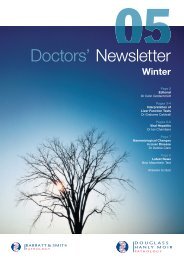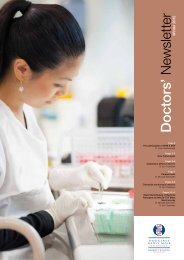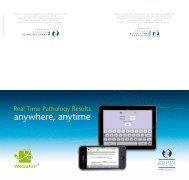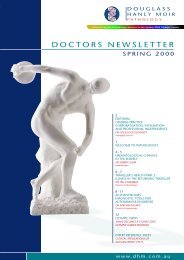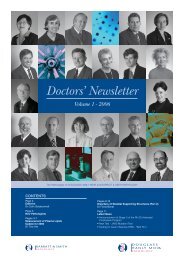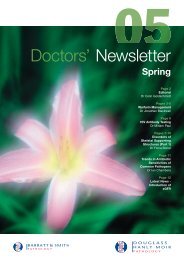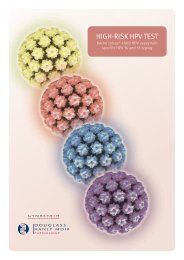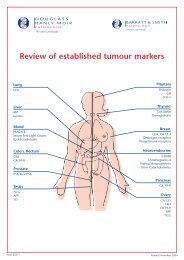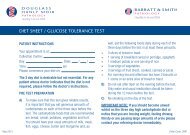Doctors' Newsletter - Autumn 2008 - Douglass Hanly Moir Pathology
Doctors' Newsletter - Autumn 2008 - Douglass Hanly Moir Pathology
Doctors' Newsletter - Autumn 2008 - Douglass Hanly Moir Pathology
Create successful ePaper yourself
Turn your PDF publications into a flip-book with our unique Google optimized e-Paper software.
Neutrophils: The Good, The Bad and the Ugly<br />
Dr Debbie Clark<br />
Haematologist<br />
Neutrophilia<br />
In the normal adult full blood count,<br />
neutrophils form the majority<br />
cell percentage of the white cell<br />
differential count. Their main function<br />
is to fight bacterial infection and the<br />
majority of cases with neutrophilia will<br />
be due to infection, an association<br />
that doctors are universally familiar<br />
with.<br />
The absolute neutrophil count is<br />
of greater significance than the<br />
percentage. Reference range in a<br />
normal adult is: 2.0 – 7.5 x 10^9 /L.<br />
Commonly, a left shift is also<br />
reported at the time of a neutrophilia.<br />
This simply means that less mature<br />
cells of the same series, such as<br />
band forms or even myelocytes,<br />
are also present in the film.<br />
See diagram 1.<br />
Although most neutrophilias<br />
will be secondary to obvious<br />
infection, sometimes there is no<br />
clinical indication of this and then<br />
the question arises: what is this<br />
neutrophilia due to and should I be<br />
worried about it At the back of<br />
everyone’s mind is the possibility of<br />
an early myeloid leukaemia. There<br />
are, however, a substantial number of<br />
other causes of a neutrophilia which<br />
are more common than primary<br />
marrow disorders. Table 1 lists them.<br />
Physiological causes of a<br />
neutrophilia are a result of circadian<br />
rhythms and reaction to physiological<br />
processes. The neutrophil count<br />
rises after a meal and after physical<br />
exertion.<br />
Pregnancy is frequently associated<br />
with a neutrophilia and our quoted<br />
reference ranges on the full blood<br />
count report reflect these changes, if<br />
we have sufficient clinical information<br />
to that effect. However, the ranges<br />
are not so readily fixed as in the<br />
non-pregnant state and should be<br />
interpreted with a degree of flexibility.<br />
Myelocytes are a common finding.<br />
Many factors influence the neutrophil<br />
count in pregnancy: the stage of<br />
pregnancy and the presence of a<br />
multiple pregnancy, for example.<br />
Some drugs are often associated<br />
with a neutrophilia: steroids are<br />
a frequently observed cause of a<br />
neutrophilia and myelocytes are often<br />
seen in the film. Of course, patients<br />
on steroids may have an increased<br />
risk of infection, which complicates<br />
the interpretation of this finding.<br />
Other drugs include: lithium, and<br />
GCSF.<br />
Inflammation of tissue without<br />
bacterial infection may also give rise<br />
to a neutrophilia. Examples include<br />
myocardial infarction, tissue necrosis,<br />
trauma and vasculitis.<br />
Acute haemorrhage or<br />
haemolysis, neoplasia, as well as<br />
some acute metabolic disorders<br />
may all sometimes be associated<br />
with a neutrophilia. Lastly, a<br />
neutrophilia may be an early sign of<br />
a myeloproliferative disorder. In<br />
chronic myeloid leukaemia, it is<br />
the predominant feature of the blood<br />
count, with a white count often in the<br />
200-300 x 10^9 /L range. In its very<br />
early stages, there may be a milder<br />
neutrophilia, but there is often quite<br />
a marked left shift. The presence<br />
of a basophilia or eosinophilia, plus<br />
changes in other parameters, such<br />
as the platelets, may give a clue to<br />
the underlying disorder.<br />
Other myeloproliferative disorders,<br />
such as polycythaemia rubra<br />
vera and myelofibrosis, may<br />
also include a neutrophilia<br />
among their features. Chronic<br />
myelomonocytic leukaemia,<br />
a disorder of the elderly which<br />
includes both myeloproliferative and<br />
myelodysplastic features, usually<br />
shows a marked monocytosis with<br />
an accompanying neutrophilia and<br />
left shift.<br />
Table 1: Causes of a neutrophilia<br />
Bacterial infection<br />
Tissue inflammation / necrosis<br />
Drugs (e.g. steroids)<br />
Pregnancy<br />
Acute haemorrhage or haemolysis<br />
Neoplasia<br />
Severe metabolic disorders<br />
Myeloproliferative disease<br />
6



